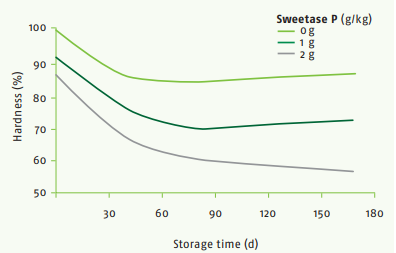Knowde Enhanced TDS
Identification & Functionality
- Chemical Family
- Enzyme Type
- Ingredient Name
- Food Ingredients Functions
- Ingredients
- Invertase
- Food Additive Number
- E 1103, INS 1103
- Technologies
Features & Benefits
- Food Ingredients Features
Applications & Uses
- Markets
- Applications
- Food & Nutrition Applications
Properties
- Appearance
- Granulated powder
- Chemical Properties
- Typical Properties
- Microbiological Values
| Value | Units | Test Method / Conditions | |
| Arsenic Content | max. 3 | mg/kg | AAS |
| Cadmium Content | max. 0.5 | mg/kg | AAS |
| Lead Content | max. 5 | mg/kg | AAS |
| Loss on Drying | max. 14 | g/100g | drying oven; 3h 105°C |
| Mercury Content | max. 0.5 | mg/kg | AAS |
| Value | Units | Test Method / Conditions | |
| Invertase | 1900 - 2100 | u/g | according to Sumner |
| Value | Units | Test Method / Conditions | |
| Escherichia coli | Negative | cfug/g | M. Colif.-Agar 36°C/48h |
| Salmonella | Negative | cfu/25g | DIN EN ISO 6579 |
| Total Plate Count | max. 50000 | cfu/g | DIN EN ISO 4833 |
Regulatory & Compliance
- Regulatory Information
Allergen Information: contains the allergen milk and lactose according to Regulation 1169/2011/EG, Annex II
Health Information: The products are suitable for human consumption if used accordingly to recommendations and officially allowed to be sold within Germany and the EU. The product is food grade and conforms with the current european food law.
GMO: This product is not a genetically modified organism (GMO), nor does it contain any GMO or any recombinant DNA.
All the non-enzymatic constituents of the product (e.g. carriers, stabilizing agents, free-flowing agents etc.) originate from non-genetically modified sources. Due to the ubiquitous presence of GMO organisms, absence of minor traces of GMO material cannot be guaranteed, but in any case, the content of unintentionally present GMO material will be below 0.9%, in accordance to EU guidelines 1830/2003 and 1829/2003. The product is used as processing aid in food manufacturing processes, and therefore labeling is not required in the EU. National regulations must be observed.Product suitability:
Yes No Vegetarian X Vegan X BSE/TSE Information: The mentioned product does not represent a BSE (Bovine Spongiform Encephalopathy) and/or TSE (Transmissible Spongiform Encephalopathy) risk.
Irradiation: Neither the product nor its ingredients have been treated with ionizing radiation according to Directive 1999/2/EC and 1999/3/EC
Nanoparticles: The product does not contain ingredients in the form of engineered nanomaterials as defined in Regulation (EU) 2015/2283.
Contamination/Residues: The product complies with: Regulation (EC) No 396/2005 and its amendments regarding maximum levels for pesticide residues in foodstuffs. Regulation (EC) No 1881/2006 and its amendments regarding especially maximum levels for heavy metals, mycotoxins, dioxins and PCB in foodstuffs.
Conformity of the Packaging: The packaging material complies with the provisions of Regulation (EC) No 1935/2004 and Regulation (EU) No 10/2011.
Technical Details & Test Data
- Enzyme System for Marzipan Confectionary
- Safe and cost effective conversion of sucrose
- Prolonged shelf life of confectionary
- Maintenance of confectionary texture
- Avoidance of drying out
- Reduction of sucrose crystallization
During storage, the marzipan confectionary undergoes changes that negatively affect its texture. Even if the products are coated and packed, they lose water and thus become dry and brittle. The ever present component sucrose tends to crystallize, leading to an unpleasantly gritty texture.
The application of Sweetase P prevents these unwanted reactions and thus helps to maintain the texture of marzipan confectionary.
Marzipan Confectionary
Sweetase P is an enzyme preparation specifically developed for marzipan confectionary. The invertase functioning enzyme originates from Saccharomyces cerevisiae. It converts sucrose into glucose and fructose, which reduces the crystallization of sucrose and thus prevents the formation of hard, gritty particles. In addition, fructose shows a strong tendency to bind water, which reduces the evaporation of water and changes the texture.

Development of hardness of marzipan (almond paste) upon storage with and without Sweetase P.
Optimum conditions Sweetase P Dosage [g/100kg] 100 pH 3.5 - 6 Temperature 55 °C Recommended dissolution 1:1 Marzipan with fruit
Component Amount Raw marzipan mass 100 kg Icing sugar 30 kg Candied fruits 25 kg Alcohol (e.g. fruit brandy) 5000 ml Citric acid solution (10%) 1000 ml Sweetase P solution* 300 ml Procedure
Mix the raw marzipan mass with the sugar. Add the alcohol, citric acid, and the Sweetase P solution in succession, and mix them properly. Finally, add the fruit and stir it in briefly.
*Sweetase P solution: dissolve 1 part (w/w) Sweetase P in 1 part of water (30-40°C). Keep this solution refrigerated until use within 36 h.

Sweetase P prolongs the shelf-life of almond paste (marzipan) products
Packaging & Availability
- Packaging
Cardboardbox with PE-Inliner, 25 kg net
Storage & Handling
- Storage & Shelf Life
Min. 18 months if stored cool and dry in closed original packing



